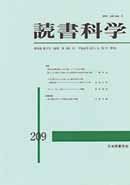This study compares classroom discourse and immediate recollections at two school grades to investigate how students acquire the listening strategies necessary for interaction and elaboration related to reading comprehension through discussions where the teacher encourages listening to others. A group of elementary school students was observed during both the fifth-and sixth-grade years(as a fifth-grade class,there were 34 children,with 13 boys and 21 girls,and as a sixth-grade class,there were 35 students,with 14 boys and 21 girls). The two observed classes were both taught by Mr.Hasegawa,who has 23 years of teaching experience,and the observations took place at about the same time during the respective school years. During the observation class at fifth-grade,the selected story was ʻGod in the Straw Bootsʼ,while ʻYamanashiʼ was the story discussed during the sixth-grade observation class. After the storyreading lessons,the students were asked to complete an immediate recall task in which they were required to freely write down the utterances they could remember. The results are follows:(1) Discourse analysis revealed that utterances involving words from the text occurred with the same frequency as utterances not involving words from the text in the discussions for both observation classes. However,the two observation classes differed in the kinds of utterances that the students were likely to pay attention to. As fifth-grade students,the class referred more frequently to utterances involving words from the text than to utterances that did not involve words from the text. In contrast,as sixth-graders,the students were more likely to refer to utterances that did not include words from the text. (2)The immediate recall task revealed that,as fifth-graders,the students were more likely to recall utterances involving words from the text than utterances that did not involve words from the text. In contrast,no significant differences were observed between the types of utterances recalled by the students as sixth-graders. During both observation classes, the students recalled significantly more utterances referring to others than those that did not. (3)An analysis of recall styles revealed that with the increase in grade,there was an increase in the frequency of recollections that not only actively captured an utteranceʼs content in their own words,but also made reference to the individual who had made the utterance.
In conclusion,these results reveal developmental changes within the acquisition of the listening strategies necessary for interaction and elaboration related to reading comprehension during discussions. Over time,the students appeared to develop the act of listening that allowed them to attend not only to utterances that involve words in the text but also to utterances that do not involve words from the text,and also to refer to the utterances made by others. By listening to such utterances,they learned to reason about utterances in their own words and to remember who spoke them. The findings indicate that, as sixth-graders, the students had developed a growing awareness for classroom discussion. However, no significant differences were observed between the two observation classes in terms of the number of recollections, which would seem to reflect the groupʼs ability to listen by integrating the contents of utterances and capturing the flow of the discussion. This suggests that elementary school students experience some difficulties with this kind of listening. Finally,in addition to developments with age,teacher encouragement to listen to others appears to influence the development of listening strategies among students.
View full abstract
